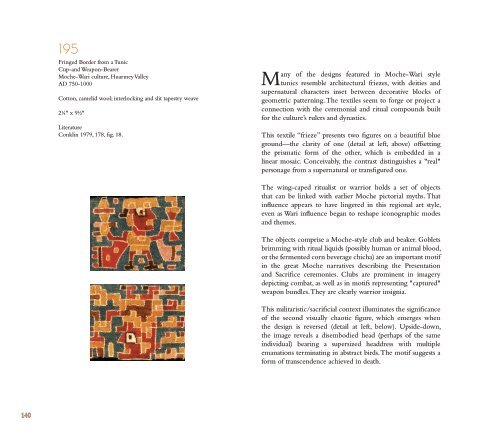You also want an ePaper? Increase the reach of your titles
YUMPU automatically turns print PDFs into web optimized ePapers that Google loves.
195<br />
Fringed Border from a Tunic<br />
Cup-and Weapon-Bearer<br />
Moche-Wari culture, Huarmey Valley<br />
AD 750-1000<br />
Cotton, camelid wool; interlocking and slit tapestry weave<br />
2¼" x 9½"<br />
Literature<br />
Conklin 1979, 178, fig. 18.<br />
Many of <strong>the</strong> designs featured in Moche-Wari style<br />
tunics resemble architectural friezes, with deities and<br />
supernatural characters inset between decorative blocks of<br />
geometric patterning. The textiles seem to forge or project a<br />
connection with <strong>the</strong> ceremonial and ritual compounds built<br />
for <strong>the</strong> culture’s rulers and dynasties.<br />
This textile “frieze” presents two figures on a beautiful blue<br />
ground—<strong>the</strong> clarity of one (detail at left, above) offsetting<br />
<strong>the</strong> prismatic form of <strong>the</strong> o<strong>the</strong>r, which is embedded in a<br />
linear mosaic. Conceivably, <strong>the</strong> contrast distinguishes a "real"<br />
personage from a supernatural or transfigured one.<br />
The wing-caped ritualist or warrior holds a set of objects<br />
that can be linked with earlier Moche pictorial myths. That<br />
influence appears to have lingered in this regional art style,<br />
even as Wari influence began to reshape iconographic modes<br />
and <strong>the</strong>mes.<br />
The objects comprise a Moche-style club and beaker. Goblets<br />
brimming with ritual liquids (possibly human or animal blood,<br />
or <strong>the</strong> fermented corn beverage chicha) are an important motif<br />
in <strong>the</strong> great Moche narratives describing <strong>the</strong> Presentation<br />
and Sacrifice ceremonies. Clubs are prominent in imagery<br />
depicting combat, as well as in motifs representing "captured"<br />
weapon bundles. They are clearly warrior insignia.<br />
This militaristic/sacrificial context illuminates <strong>the</strong> significance<br />
of <strong>the</strong> second visually chaotic figure, which emerges when<br />
<strong>the</strong> design is reversed (detail at left, below). Upside-down,<br />
<strong>the</strong> image reveals a disembodied head (perhaps of <strong>the</strong> same<br />
individual) bearing a supersized headdress with multiple<br />
emanations terminating in abstract birds. The motif suggests a<br />
form of transcendence achieved in death.<br />
140







